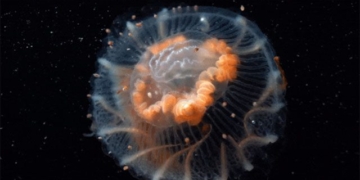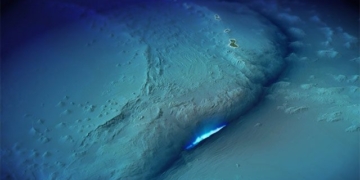A block of “cosmic diamond” is forming 104 light-years away, providing an alternative scenario for the future of Earth’s parent star.
Most stars that are similar in size to the Sun or smaller, as well as those slightly larger, will ultimately collapse into white dwarfs in their final stages of life. This form represents a “zombie” state with nearly depleted energy but still exhibiting limited activity, before eventually exploding into a supernova, dispersing the remaining material into the universe.
However, an international research team led by Dr. Alexander Venner from the University of Southern Queensland (Australia) has discovered a different fate for white dwarfs: transforming into diamonds.

Graphic depicting white dwarf transforming into diamond – (Image: HARVARD-SMITHSONIAN CENTER FOR ASTROPHYSICS).
According to Science Alert, the cosmic diamond forming is HD 190412c, approximately 4.2 billion years old, part of a system of three other known stars collectively called HD 190412.
Using data from the extremely powerful sky-mapping satellite – the Gaia spacecraft of the European Space Agency (ESA), Dr. Venner’s team discovered that HD 190412 is crystallizing vigorously due to its rich carbon and oxygen composition.
It is unclear whether it will form a literal block of diamond or some type of “super diamond” that is yet to be imagined, as the density of a white dwarf (over 1 million kg/m3) is even denser than that of diamond on Earth (3,500 kg/m3).
However, theoretically, there are carbon isotopes in the universe that allow this star to accomplish such a transformation.
The Sun itself is also a star and will eventually collapse into a white dwarf, so this new discovery presents an alternative scenario for its future—besides the most common scenario of exploding into a supernova, which is expected to occur in about 5 billion years.
The supernova scenario is more plausible, as the Sun primarily consists of helium and hydrogen, with much lower amounts of carbon and oxygen compared to the recently discovered star.
Nonetheless, it is uncertain whether our Earth will later orbit a block of diamond or be left adrift due to the loss of its parent star, as we can only reach that stage if we survive the “red giant” phase of the Sun.
Before becoming a white dwarf, it will flare up one last time into a much larger, red sphere. This dying red giant star is so massive that it may accidentally engulf several of the nearest planets, including Mercury, Venus, and possibly Earth, as some previous studies have predicted.


















































